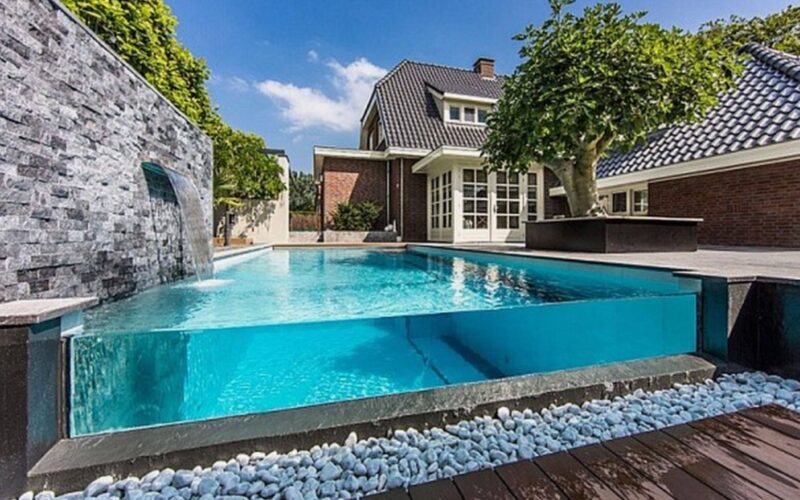Keeping a pool looking great between service visits is important for any pool owner. Regular skimming to remove leaves and debris guarantees the water stays clean and inviting. Investing a little time in simple tasks can create a refreshing and enjoyable swimming experience.
Maintaining the right chemical balance is key to preventing algae and bacteria growth. Testing the water regularly and adding chemicals helps keep the pool safe for swimming. Hiring a quality pool service Austin can provide peace of mind, guaranteeing expert care between professional cleanings.
Additionally, brushing the walls and vacuuming the pool floor can prevent dirt buildup. These steps, combined with regular professional maintenance, can help keep any pool in top condition throughout the swimming season.
Routine Cleaning and Maintenance
Regular house pool care helps keep the water clear and safe. It involves cleaning the pool’s surface, maintaining the right chemical levels, and guaranteeing the filters are working properly.
Surface Skimming and Brushing
Skimming the surface removes leaves, insects, and other debris. Doing this daily prevents unnecessary stress on the pool’s filtration system.
A long-handled skimmer net makes it easier to reach all areas. For larger debris that sinks, a pool vacuum is helpful.
Brushing the pool walls, floor, and steps twice a week removes algae and dirt. Use a brush suitable for your pool’s surface. Pay attention to corners and ladders, as these can be spots where dirt builds up easily. Regular brushing keeps these areas clean and prevents stains.
Chemical Balancing
Maintaining the correct chemical balance is important for clear water. Test the water at least once a week. Essential levels to monitor include pH, chlorine, and alkalinity.
A pH level between 7.2 and 7.8 helps chlorine work effectively. Adjust pH using specific chemicals if necessary. Proper chlorine levels prevent bacteria and algae growth. To keep everything balanced, consider using a pool water testing kit.
Shocking the pool occasionally, which means adding extra chlorine, can also help control algae and bacteria. This is best done in the evening or on days without wind.
Filter Cleaning and Replacement
The pool filter removes impurities from the water and needs regular attention. There are three main types: sand, cartridge, and diatomaceous earth (DE) filters.
Sand filters need backwashing to remove trapped dirt. Cartridge filters should be rinsed and cleaned regularly. Replace them when they wear out. DE filters require occasional backwashing and replenishing of DE powder.
Check the filters weekly and clean or replace them as needed. A clean filter supports the effectiveness of the pool’s cleaning systems, guaranteeing clear and inviting water for swimming. Regular filter maintenance also extends the life of the equipment.
Seasonal Pool Care Tips
Caring for your pool through different seasons involves adjusting maintenance routines to keep it in top condition. This means adapting to changes in temperature and usage frequency, including tasks like cleaning, covering, and water balancing.
Summer Pool Usage Preparedness
During summer, pools are used more often, requiring more attention. Regular cleaning becomes important to prevent dirt and debris buildup. Skimming the surface and vacuuming the pool should be part of the weekly routine. It is also wise to check and balance the water levels frequently to guarantee safe swimming conditions.
Chemical balance is important as the heat can cause water to evaporate, concentrating chemicals like chlorine. Testing water daily and adjusting chemical levels accordingly is a smart move. Pool equipment, such as pumps and filters, should be checked and cleaned regularly to keep them running efficiently. Use a pool cover when the pool is not in use to help keep debris out and maintain water temperature.
Winterizing Your Pool
Winterizing is the process of preparing a pool for colder months when it is not in use. Start by removing and storing accessories like ladders and toys. Cleaning the pool thoroughly to prevent stains and bacterial growth during the off-season is important.
Lower the water level to below the skimmer to prevent freezing damage and drain water from the pump, filter, and heater. Add antifreeze to the plumbing to protect the pipes from ice damage in freezing climates. Use a durable pool cover to keep out debris and prevent water evaporation. It’s recommended to check the pool cover periodically for any damage or accumulation of water and ice that might cause it to sag or tear. Regularly maintaining these elements helps the pool stay in great condition year-round.
Conclusion
Keeping a pool looking great between professional services requires regular attention and simple tasks. Consistent cleaning is the key, including removing toys and debris and vacuuming. These tasks help maintain water clarity and prevent issues like algae buildup.
Regular brushing of the pool’s sides and floor helps prevent calcium deposits and algae formation. Guaranteeing equipment like vacuums and hoses are in good condition is also important for effective cleaning.
Simple actions like keeping garbage out of the pool can prevent dirt and clutter. Paying attention to these details makes pool maintenance easy and enjoyable.
By following these guidelines, pool owners can maintain a clean and inviting swimming area all season long.
